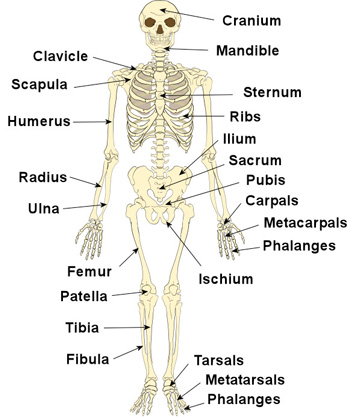Bone: Difference between revisions
No edit summary |
No edit summary |
||
| (19 intermediate revisions by 7 users not shown) | |||
| Line 1: | Line 1: | ||
There are two-hundred and six bones in the adult human body<ref>Denise M. Covert, R.N.. (2011). How Many Bones Are There in the Human Body?. Available: http://howmanyarethere.net/how-many-bones-are-there-in-the-human-body/. Last accessed 23rd Oct 2012</ref> | [[Image:Skeleton350.jpg|right|Labelled human skeleton]]There are two-hundred and six bones in the adult human body<ref>Denise M. Covert, R.N.. (2011). How Many Bones Are There in the Human Body?. Available: http://howmanyarethere.net/how-many-bones-are-there-in-the-human-body/. Last accessed 23rd Oct 2012</ref><ref>TeachPE. 2016 [cited 04/12/2016]; Available from: http://www.teachpe.com/anatomy/skeleton.php</ref>. Children have more bones (270 as an infant), as bones in the skull are separate and have not yet fused together ([[Ossification|ossification]]). These bones make up the [[Skeletal system|skeletal system]] which helps support the body and aid in movement. Bones are constantly being remodelled. In the human skeleton, there are two main types of bone: long bones and flat bones<ref>Biology for the Medical Sciences, P. Bradley and J. Calvert</ref>, and three others - short, irregular and sesamoid. Long bones, such as the femur (thigh bone), are made up of a long shaft and two ends. the shaft contains a cavity filled with [[Bone marrow|bone marrow]]. They provide strength, structure and mobility. Flat bones are mainly found in the [[Skull|skull]], ilium, sternum and ribcage and are made of two thin layers of compact bone, with a layer of cancellous bone in between them<ref>http://www.teachpe.com/anatomy/types_of_bones.php (Last accessed 25th Oct 2012)</ref>. it protects other organs and provides a framework for [[Muscle|muscles]] to attach. | ||
=== References | === References === | ||
<references /> | <references /> | ||
Latest revision as of 20:06, 6 December 2017

There are two-hundred and six bones in the adult human body[1][2]. Children have more bones (270 as an infant), as bones in the skull are separate and have not yet fused together (ossification). These bones make up the skeletal system which helps support the body and aid in movement. Bones are constantly being remodelled. In the human skeleton, there are two main types of bone: long bones and flat bones[3], and three others - short, irregular and sesamoid. Long bones, such as the femur (thigh bone), are made up of a long shaft and two ends. the shaft contains a cavity filled with bone marrow. They provide strength, structure and mobility. Flat bones are mainly found in the skull, ilium, sternum and ribcage and are made of two thin layers of compact bone, with a layer of cancellous bone in between them[4]. it protects other organs and provides a framework for muscles to attach.
References
- ↑ Denise M. Covert, R.N.. (2011). How Many Bones Are There in the Human Body?. Available: http://howmanyarethere.net/how-many-bones-are-there-in-the-human-body/. Last accessed 23rd Oct 2012
- ↑ TeachPE. 2016 [cited 04/12/2016]; Available from: http://www.teachpe.com/anatomy/skeleton.php
- ↑ Biology for the Medical Sciences, P. Bradley and J. Calvert
- ↑ http://www.teachpe.com/anatomy/types_of_bones.php (Last accessed 25th Oct 2012)